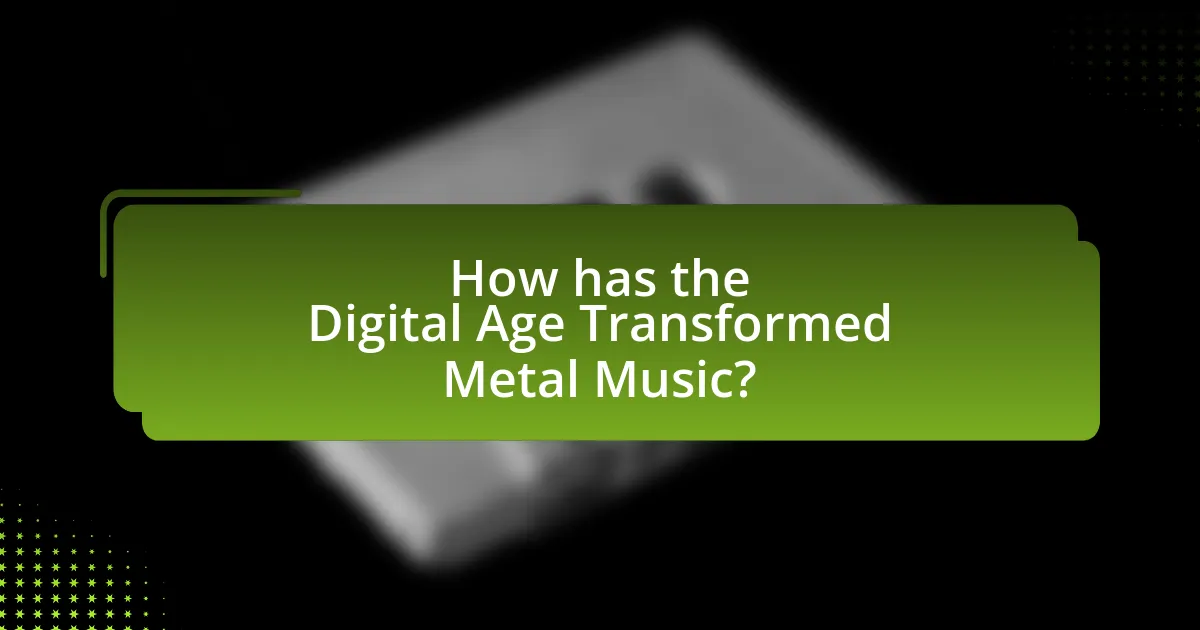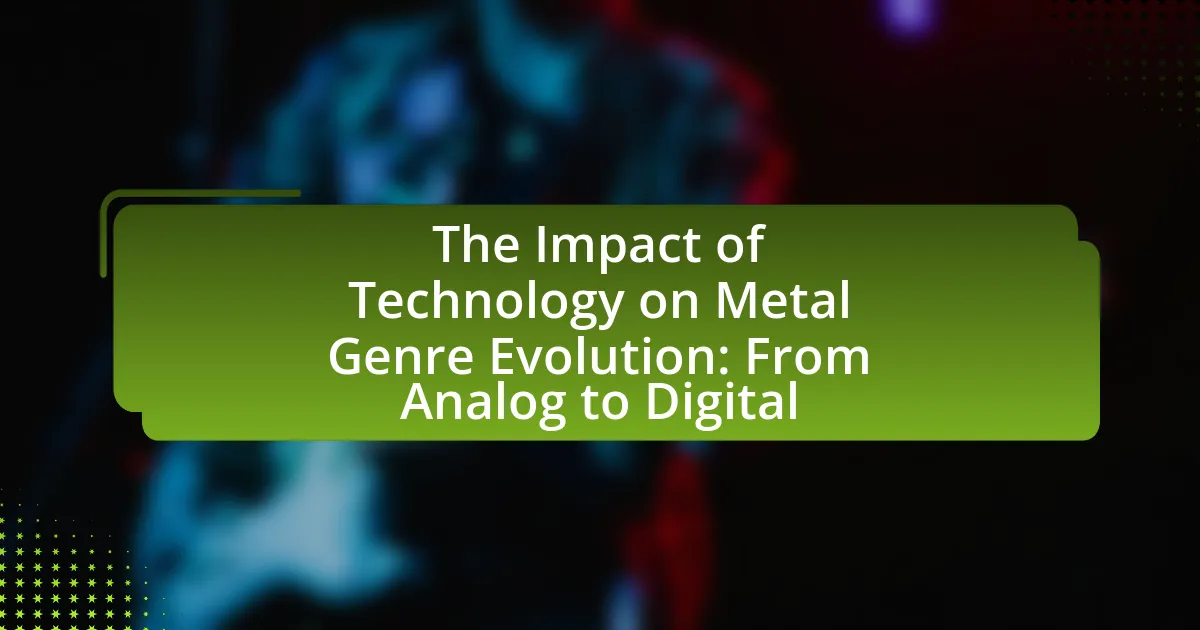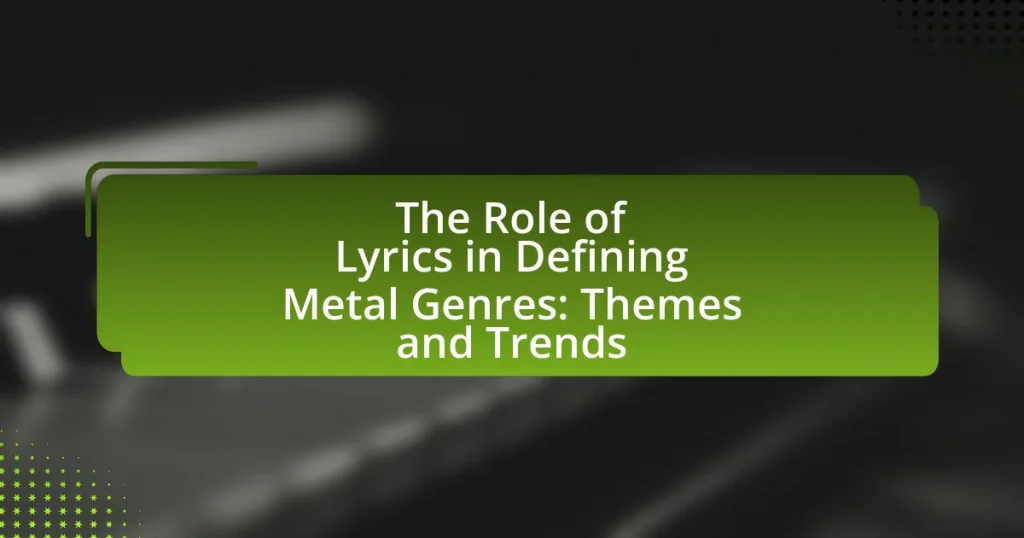The article examines the significant impact of technology on the evolution of the metal genre, highlighting the transition from analog to digital methods in music production, distribution, and consumption. It discusses how advancements in digital audio workstations, recording techniques, and online platforms have transformed the sound of metal music, enabling the emergence of new subgenres and enhancing production quality. Additionally, the article explores the role of social media and streaming services in promoting metal music and connecting artists with global audiences, as well as future trends such as artificial intelligence and virtual reality that may further influence the genre.

What is the Impact of Technology on Metal Genre Evolution?
The impact of technology on metal genre evolution is profound, as it has transformed production, distribution, and the overall sound of the genre. Advances in recording technology, such as digital audio workstations and software plugins, have allowed metal musicians to experiment with complex arrangements and high-fidelity sound, leading to subgenres like metalcore and djent. Additionally, the rise of the internet and streaming platforms has changed how metal is distributed and consumed, enabling niche bands to reach global audiences without traditional record label support. For instance, the accessibility of home recording equipment has democratized music production, allowing independent artists to produce high-quality recordings, which has significantly contributed to the diversification of the metal genre.
How has technology influenced the sound of metal music?
Technology has significantly influenced the sound of metal music by enabling advanced production techniques and innovative instrumentation. The introduction of digital recording and editing software has allowed musicians to manipulate sound with precision, resulting in more complex arrangements and polished recordings. For instance, the use of digital audio workstations (DAWs) like Pro Tools and Logic Pro has become standard in metal production, facilitating intricate layering of guitar tracks and the incorporation of electronic elements. Additionally, advancements in guitar technology, such as the development of high-gain amplifiers and effects pedals, have expanded the tonal possibilities for metal guitarists, allowing for heavier and more aggressive sounds. The evolution from analog to digital has not only enhanced the quality of recordings but also democratized music production, enabling independent artists to produce high-quality metal music without the need for expensive studio time.
What specific technological advancements have shaped metal music?
Digital recording technology has significantly shaped metal music by allowing for greater precision and creativity in sound production. The introduction of digital audio workstations (DAWs) in the 1990s enabled musicians to record, edit, and mix music with unprecedented ease and flexibility. This shift from analog to digital not only improved sound quality but also facilitated complex layering of instruments and effects, which are hallmarks of the metal genre. Additionally, advancements in guitar technology, such as the development of high-gain amplifiers and digital effects pedals, have allowed metal guitarists to achieve heavier and more intricate sounds. The rise of the internet and streaming platforms has also transformed how metal music is distributed and consumed, enabling niche subgenres to flourish and reach global audiences.
How do these advancements affect the production quality of metal albums?
Advancements in technology significantly enhance the production quality of metal albums by enabling more precise sound manipulation and improved recording techniques. Digital audio workstations (DAWs) allow for intricate editing, layering, and effects that were not possible with analog equipment, resulting in cleaner and more polished final products. For instance, the use of plugins for virtual instruments and effects can create complex soundscapes that elevate the overall listening experience. Additionally, advancements in audio interfaces and microphones improve the clarity and fidelity of recordings, allowing for a more accurate representation of the musicians’ performances. This shift from analog to digital has led to a notable increase in production standards within the metal genre, as evidenced by the high-quality outputs of contemporary metal bands compared to earlier recordings.
Why is the transition from analog to digital significant for metal?
The transition from analog to digital is significant for metal because it has transformed production, distribution, and consumption methods within the genre. Digital technology allows for higher fidelity sound, enabling metal artists to achieve more complex and polished recordings, which enhances the listening experience. Additionally, digital platforms have democratized music distribution, allowing independent metal bands to reach global audiences without the need for traditional record labels. This shift has led to a surge in the diversity of metal subgenres and increased accessibility for fans, as evidenced by the rise of streaming services that host vast catalogs of metal music.
What are the key differences between analog and digital recording techniques?
Analog recording techniques capture sound waves as continuous signals, while digital recording techniques convert sound waves into discrete numerical values. Analog systems, such as tape recorders, produce a warm, natural sound due to their continuous nature, but they are susceptible to noise and degradation over time. In contrast, digital systems, like computer-based recording, offer higher fidelity and the ability to manipulate sound without loss of quality, as they store audio as binary data. The transition from analog to digital has allowed for greater editing flexibility and consistency in sound reproduction, significantly influencing the production quality in the metal genre.
How has the shift to digital changed the way metal is consumed by audiences?
The shift to digital has transformed metal consumption by enabling instant access to music and fostering global connectivity among fans. Audiences can now stream metal tracks on platforms like Spotify and YouTube, which has increased exposure for both established and emerging artists. According to a 2021 report by the International Federation of the Phonographic Industry, streaming accounted for 62% of global recorded music revenues, highlighting the dominance of digital formats. Additionally, social media platforms allow fans to engage directly with artists, share content, and participate in virtual events, further enhancing community interaction within the metal genre. This digital landscape has shifted the focus from physical album sales to online engagement and streaming metrics, fundamentally altering how metal is experienced and consumed.
What role does technology play in the evolution of metal subgenres?
Technology plays a crucial role in the evolution of metal subgenres by enabling innovative sound production, distribution, and accessibility. The advent of digital recording techniques allowed for greater experimentation with sound, leading to the emergence of subgenres like metalcore and djent, which incorporate complex rhythms and production effects. Additionally, the internet revolutionized music distribution, allowing niche subgenres to reach global audiences, as seen with the rise of bands like Babymetal, which blends metal with J-pop influences. Furthermore, advancements in software and hardware have facilitated the creation of intricate compositions and live performances, pushing the boundaries of what defines metal music.
How have digital tools influenced the emergence of new metal subgenres?
Digital tools have significantly influenced the emergence of new metal subgenres by enabling musicians to experiment with sound and production techniques that were previously inaccessible. The advent of digital audio workstations (DAWs) and software synthesizers has allowed artists to blend genres, leading to the creation of subgenres like metalcore and djent, which incorporate elements from electronic music and hardcore punk. For instance, the use of plugins and virtual instruments has facilitated complex layering and sound manipulation, resulting in innovative compositions that push the boundaries of traditional metal. Additionally, online platforms have democratized music distribution, allowing niche subgenres to gain traction and reach global audiences, exemplified by the rise of bands like Periphery and Bring Me The Horizon, who utilize digital tools to craft their unique sounds.
What impact does technology have on the creativity of metal musicians?
Technology significantly enhances the creativity of metal musicians by providing advanced tools for composition, production, and distribution. Digital audio workstations (DAWs) allow musicians to experiment with complex arrangements and sound design that were previously difficult or impossible to achieve with analog equipment. For instance, the use of software synthesizers and virtual instruments enables metal artists to explore a wider range of sounds and textures, leading to innovative musical styles. Additionally, technology facilitates collaboration across geographical boundaries, allowing musicians to work together remotely, which can inspire new ideas and influences. The rise of online platforms for sharing music has also democratized access to audiences, enabling metal musicians to reach global listeners without traditional gatekeepers, further fostering creative expression.

How has the Digital Age Transformed Metal Music?
The Digital Age has transformed metal music by enabling widespread access to production tools, distribution platforms, and fan engagement methods. Digital audio workstations (DAWs) have democratized music production, allowing independent artists to create high-quality recordings without the need for expensive studio time. Additionally, streaming services like Spotify and YouTube have revolutionized how metal music is consumed, providing global reach and instant access to a vast catalog of songs. This shift has led to increased visibility for underground bands and niche subgenres, as evidenced by the rise of platforms like Bandcamp, which empower artists to sell directly to fans. Furthermore, social media has facilitated direct interaction between musicians and their audience, fostering a sense of community and engagement that was less accessible in the analog era.
What are the main digital platforms that have affected metal music distribution?
The main digital platforms that have affected metal music distribution are Spotify, Apple Music, Bandcamp, and YouTube. Spotify revolutionized music streaming by providing access to a vast library of songs, allowing metal bands to reach global audiences without traditional distribution barriers. Apple Music similarly offers extensive streaming services and curated playlists that promote metal artists. Bandcamp has empowered independent metal musicians by enabling direct sales and fan engagement, fostering a community around niche genres. YouTube serves as a significant platform for music videos and live performances, allowing metal bands to showcase their work and connect with fans visually. These platforms collectively transformed how metal music is distributed and consumed, facilitating greater accessibility and exposure for artists.
How do streaming services change the way metal bands reach their audience?
Streaming services significantly alter how metal bands connect with their audience by providing global access to their music. These platforms enable bands to distribute their tracks widely without the need for traditional record labels, allowing for greater independence and reach. For instance, according to a 2021 report by the International Federation of the Phonographic Industry, streaming accounted for 62% of global recorded music revenue, highlighting its dominance in music consumption. This shift allows metal bands to engage with fans directly through playlists, social media integration, and algorithm-driven recommendations, fostering a more interactive relationship. Additionally, the data analytics provided by streaming services help bands understand their audience demographics and preferences, enabling targeted marketing strategies.
What role do social media and online communities play in promoting metal music?
Social media and online communities play a crucial role in promoting metal music by providing platforms for artists to share their work and connect with fans globally. These digital spaces enable musicians to reach wider audiences without the constraints of traditional media, facilitating the discovery of new bands and genres. For instance, platforms like Facebook, Instagram, and YouTube allow artists to share music videos, live performances, and engage directly with fans, fostering a sense of community. According to a 2020 study by the International Journal of Music Business Research, 70% of metal fans reported discovering new music through social media, highlighting its effectiveness in promotion. Additionally, online communities, such as forums and fan groups, create environments for discussion and sharing, further amplifying the reach and impact of metal music.
How has technology changed the live performance aspect of metal music?
Technology has significantly transformed the live performance aspect of metal music by enhancing sound quality, stage production, and audience engagement. Advanced sound systems, such as digital mixing consoles and high-fidelity speakers, allow for clearer and more powerful audio, enabling bands to deliver a more immersive experience. Additionally, the use of lighting technology, including LED displays and laser shows, creates visually stunning performances that complement the music.
Moreover, live streaming technology has expanded the reach of metal concerts, allowing fans worldwide to experience performances in real-time, which was not possible before. According to a 2021 report by the International Federation of the Phonographic Industry, live streaming events saw a 50% increase in viewership during the pandemic, highlighting the growing importance of technology in live music. These advancements collectively enhance the overall concert experience for both performers and audiences.
What innovations in live sound technology enhance metal concerts?
Innovations in live sound technology that enhance metal concerts include advanced digital mixing consoles, in-ear monitoring systems, and high-fidelity speaker systems. Digital mixing consoles allow for precise control over sound levels and effects, enabling sound engineers to tailor the audio experience to the unique dynamics of metal music, which often features complex arrangements and heavy instrumentation. In-ear monitoring systems provide musicians with personalized audio feeds, reducing stage noise and allowing for better performance synchronization. High-fidelity speaker systems, including line array setups, deliver clearer and more powerful sound, ensuring that the intense energy of metal performances is effectively conveyed to the audience. These technologies collectively improve sound quality, clarity, and overall concert experience, making them essential for modern metal performances.
How do digital effects and software influence live metal performances?
Digital effects and software significantly enhance live metal performances by allowing musicians to manipulate sound in real-time, creating a more immersive experience. These technologies enable the use of complex soundscapes, layering of multiple effects, and precise control over tone and dynamics, which are essential in metal music’s intricate compositions. For instance, guitarists can utilize digital pedals and software to achieve a variety of tones, from heavy distortion to ambient effects, which can be adjusted on-the-fly during a performance. This adaptability not only enriches the auditory experience but also allows for greater creativity and experimentation on stage. Additionally, software can facilitate the integration of backing tracks and samples, further expanding the sonic palette available to live performers.

What Future Trends Can We Expect in Metal Music Technology?
Future trends in metal music technology will likely include advancements in artificial intelligence for music composition, enhanced virtual reality experiences for live performances, and the integration of blockchain for music distribution and rights management. AI tools are already being used to create complex compositions, allowing artists to experiment with new sounds and styles, as seen in projects like OpenAI’s MuseNet. Virtual reality is set to revolutionize live shows, providing immersive experiences that can reach global audiences, as demonstrated by platforms like Oculus Venues. Additionally, blockchain technology is gaining traction for its ability to ensure transparency and fair compensation for artists, with initiatives like Audius leading the way in decentralized music sharing. These trends indicate a significant shift towards more innovative, accessible, and equitable practices in the metal music industry.
How might emerging technologies further influence metal music?
Emerging technologies will further influence metal music by enhancing production techniques, expanding creative possibilities, and facilitating global collaboration. Advanced software tools, such as AI-driven music composition programs, allow musicians to experiment with complex arrangements and generate unique sounds, pushing the boundaries of traditional metal. Additionally, virtual reality and augmented reality technologies can create immersive concert experiences, engaging fans in new ways. The rise of streaming platforms and social media enables artists to reach wider audiences and collaborate with musicians worldwide, fostering innovation within the genre. For instance, the use of digital audio workstations has revolutionized recording processes, making high-quality production accessible to independent artists, which has led to a diversification of metal subgenres.
What potential does artificial intelligence hold for metal music creation?
Artificial intelligence holds significant potential for metal music creation by enabling innovative composition, sound design, and production techniques. AI algorithms can analyze vast datasets of existing metal music to generate new compositions that reflect the genre’s complexity and intensity. For instance, tools like OpenAI’s MuseNet can create original music in various styles, including metal, by learning from patterns in existing tracks. Additionally, AI can assist in sound engineering by optimizing mixing and mastering processes, thereby enhancing the overall production quality. The integration of AI in metal music not only streamlines creative workflows but also opens avenues for unique sonic experimentation, as evidenced by projects like AIVA, which has been used to compose music across multiple genres, including metal.
How could virtual reality change the experience of metal concerts?
Virtual reality could revolutionize the experience of metal concerts by providing immersive environments that enhance audience engagement. Through VR technology, fans can experience concerts from various perspectives, such as being on stage with the band or in the front row, regardless of their physical location. This capability allows for a more personalized and interactive experience, as users can choose their vantage point and even interact with virtual elements, such as band members or other fans.
Moreover, studies indicate that immersive experiences can increase emotional responses and satisfaction levels among participants. For instance, a study published in the Journal of Virtual Reality in 2021 found that users reported heightened feelings of presence and enjoyment during virtual concerts compared to traditional viewing methods. This suggests that virtual reality could not only replicate but also enhance the live concert experience, making it more accessible and engaging for metal fans worldwide.
What best practices should metal musicians adopt in the digital age?
Metal musicians should adopt a multi-faceted digital strategy that includes leveraging social media, utilizing streaming platforms, and engaging with their audience through direct communication. Social media platforms like Instagram and TikTok allow musicians to showcase their work, connect with fans, and build a community, which is essential for visibility in a crowded market. Streaming platforms such as Spotify and Apple Music provide access to a global audience, enabling musicians to distribute their music widely and gain royalties based on streams. Additionally, direct engagement through newsletters and live streams fosters a loyal fanbase and creates opportunities for merchandise sales and crowdfunding. These practices are supported by the fact that, according to a 2021 report by the International Federation of the Phonographic Industry, streaming accounted for 62% of global recorded music revenue, highlighting the importance of digital presence for financial success in the music industry.
How can metal artists effectively leverage technology for their careers?
Metal artists can effectively leverage technology for their careers by utilizing digital platforms for music distribution, social media for audience engagement, and advanced production tools for high-quality recordings. Digital platforms like Spotify and Bandcamp allow artists to reach global audiences without the need for traditional record labels, enabling independent releases that can lead to increased revenue and fanbase growth. Social media platforms such as Instagram and TikTok facilitate direct interaction with fans, allowing artists to build a community and promote their work in real-time. Additionally, technology such as digital audio workstations (DAWs) and software plugins provide artists with the means to produce professional-grade music from home, reducing costs associated with studio time and enabling creative experimentation. These methods have been shown to enhance visibility and profitability in the music industry, as evidenced by the rise of independent artists who have successfully navigated the digital landscape.
What strategies can metal bands use to adapt to technological changes?
Metal bands can adapt to technological changes by embracing digital platforms for music distribution, utilizing social media for fan engagement, and incorporating advanced production techniques. By distributing music through streaming services like Spotify and Apple Music, bands can reach a global audience more efficiently than traditional methods. Social media platforms such as Instagram and TikTok allow bands to connect with fans directly, promoting their music and building a community. Additionally, the use of digital audio workstations (DAWs) and software plugins enables bands to experiment with new sounds and production styles, enhancing their creative output. These strategies have been validated by the rise of successful independent metal bands that leverage technology to thrive in a competitive industry.



